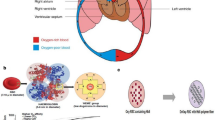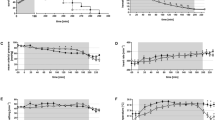Abstract
The oxygen transporting capability of an artificial oxygen carrier NRC was evaluated by employing it as a perfusate for total cardiopulmonary bypass. NRC is a type of liposome encapsulated hemoglobin. It has a particle size of approximately 220 nm, with a hemoglobin concentration of 5.6 g/dl and its P50 is controlled to 45 Torr. Male beagles were used in the experiment. Approximately 80% of the estimated circulatory volume was exchanged with NRC and total cardiopulmonary bypass was initiated. Arterial oxygen tension and carbon dioxide tension were controlled to 400 Torr and 40 Torr respectively. The perfused we heated to 37°C. The rate of flow was altered during the experiment. Oxygen consumption reached a plateau at 9.3 ml/kg/min where oxygen delivery was 14.9 ml/kg/min. At this point the oxygen consumed per gram of hemoglobin from NRC was equivalent to that from dog red blood cells. This indicated that almost an equal amount of oxygen was consumed from NRC in comparison to red blood cells. Regarding oxygen transporting capability, NRC could be considered a candidate for perfusate in cardiopulmonary bypass.
Similar content being viewed by others
References
Tomasulo P: Transfusion alternatives. Impact on blood banking worldwide, Winslow RM, Vandegriff KD, Intaglietta M, ed., Blood substituters. Physiological basis of efficacy. Boston, 1995, Birkhauser, p1–19
Tsuchida E: Introduction. Overview and Perspectives, Tsuchida E, ed., Artificial Red Cells, New York, 1995, John Wiley & Sons, p1–20
19: 1477–1482, 1995
Zuck TF, Riess JG: Current status of injectable oxygen carriers. Crit Rev Clin Lab Sci 31: 295–324, 1994
Chang TMS: Blood substitutes based on modified hemoglobin prepared by encapsulation or crosslinking. An overview. Biomater Artif Cells Immobilization Biotechnol 20: 159–182, 1992
Looker D, Abbott-Brown D, Cozart P, Durfee S, Hoffman S, Mathews AJ, Miller-Roehrich J, Shoemaker S, Trimble S, Fermi G, Komiyama NH, Nagai K, Stetler GL: A human recombinant haemoglobin designed for use as a blood substitutes. Nature 356: 258–260, 1992
Djordjevich L, Miller IF: Synthetic erythrocytes from lipid encapsulated hemoglobin. Exp Hemat 8: 584–592, 1980
Zheng S, Beissinger R, Sherwood RL, McCormic DL, Lasic DD, Martin FJ: Liposome-encapsulated hemoglobin. A red blood cell substitute. J Liposome Res 3: 575–588, 1993
Kobayashi K, Tsuchida E, Nishide H: Totally synthetic hemes. Their characteristics and oxygen-carrying capacity in dogs, Tsuchida E, ed., Artificial Red Cells, New York, 1995, John Wiley & Sons Ltd, p93–116
17: 729–732, 1988
17: 708–711, 1988
(NRC) 20: 626–630, 1991
(NRC) 7: 230–238, 1993
Ogata Y, Goto H, Sakaguchi K, Suzuki M, Ohsaki K, Suzuki K, Saniabadi AR, Kamitani K, Takahashi A: Characteristics of Neo Red Cells, their function and safety. In vivo studies. Art Cells Blood Subs and Immob Biotech 22: 875–881, 1994
Takahashi A: Characterization of Neo Red Cells (NRCs), their function and safety in vivo tests. Art Cells Blood Subs and Immob Biotech 23: 347–354, 1995
Izumi Y, Sakai H, Hamada K, Takeoka S, Yamahata T, Kato R, Nishide H, Tsuchida E, Kobayashi K: Physiologic responses to exchange transfusion with hemoglobin vesicles as an artificial oxygen carrier in anesthetized rats. Changes in mean arterial pressure and renal cortical oxygen tension. Crit Care Med 24: 1869–1873, 1996
7: 422–425, 1978
15: 1035–1037, 1967
Miller MJ: Tissue oxygenation in clinical medicine. An historical review. Anes Anaig 61: 527–535, 1982
Kandel G, Aberman A: Mixed venous oxygen saturation. Its role in the assessment of the critically ill patient. Arch Intern Med 143: 1400–1402, 1983
35: 599–607, 1987
Villar J, Slutsky AS, Hew E, Aberham A: Oxygen transport and oxygen consumption in critically ill patients. Chest 98: 687–692, 1990
Cohen AH, Nast CC: Anderson’s Pathology, Damjanov I, Linder J, ed., St. Louis, 1996, Mosby-Year Book, Inc., p2117–2120
29: 153–163, 1974
16: 299–310, 1984
1991, p159–169
Author information
Authors and Affiliations
Rights and permissions
About this article
Cite this article
Izumi, Y., Yamahata, T., Yozu, R. et al. The oxygen transporting capability of neo red cells (NRC) evaluated under total cardiopulmonary bypass. Jpn J Thorac Caridovasc Surg 46, 30–37 (1998). https://doi.org/10.1007/BF03217719
Received:
Accepted:
Issue Date:
DOI: https://doi.org/10.1007/BF03217719




